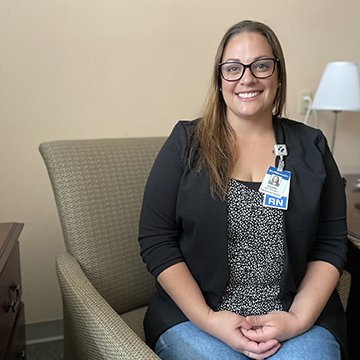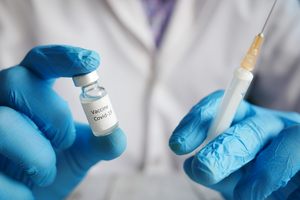[ad_1]
LMH Health recently launched remote patient monitoring, an innovative new program to better serve patients with chronic and uncontrolled conditions at home.
Remote patient monitoring (RPM) is simple: Patients use a digital medical device at home to regularly capture their health data, such as weight, heart rate, blood pressure or blood sugar. The device connects to an application on their smartphone, which sends this data in real-time to the patient’s provider to review – and intervene, if necessary.
The RPM program is another step toward the preventative healthcare model that LMH Health has been adapting over the past decade, said Janette Kirkpatrick, vice president of clinical excellence at LMH Health.
“RPM makes healthcare more accessible to patients,” said Kirkpatrick. “With regular monitoring of a patient’s condition, providers are able to immediately recognize a problem and work with the patient to correct it. This will keep individuals out of more serious, emergency-department situations – and, ultimately, lower an individual’s healthcare cost.”
Am I eligible to participate in RPM?
RPM is part of LMH Health’s population health management program, which focuses on improving health outcomes of specific groups through patient engagement and care coordination.
LMH Health’s RPM program currently focuses on patients with, or at risk for, chronic or uncontrolled conditions like diabetes, hypertension and heart failure. LMH Health plans to grow the program to monitor other diseases as more patients enroll in the program.
According to the Centers for Disease Control and Prevention, 6 out of 10 adults in the U.S. have a chronic condition, while 4 out of 10 adults have two or more chronic conditions.
To assist uninsured patients and those who are unable to pay the out-of-pocket cost for RPM, the LMH Health Foundation is providing donor funds to cover the cost.
“Through the pandemic, we realized the value of remote services,” said Kirkpatrick. “RPM is one vital way that LMH Health is ensuring access to quality healthcare for all community members.”
How does RPM work?
The health data collected by the devices is transmitted directly to the patient’s record. Significant changes in health – like blood pressure measuring too high – trigger a notification to the provider who can review the result in real-time and call the patient to check-in.

Caitlin Bowlin, RN
Caitlin Bowlin, RN, is the LMH Health nurse who actively monitors the patients enrolled in RPM. She reaches out to patients when their health changes and communicates with their primary care physicians or other specialists as needed.
Bowlin, who previously worked 10 years in emergency nursing, said that moving to a role that focuses on preventative care was a positive change for her.
“I’m used to caring for people who come to the hospital because they’re sick,” said Bowlin. “Working on the RPM program is amazing – we are catching things early, and we are able to intervene when we see an individual’s health trends going the wrong way. We are hopeful this will decrease unnecessary visits and hospitalizations altogether.”
Efficient, effective healthcare
Although LMH Health’s RPM program has only existed for a few months, Bowlin has already seen the benefits of the program.
“Patients feel cared about, knowing that someone is keeping an eye on their health,” Bowlin said. “People really like this one-on-one care and having an additional provider they can reach out to when needed.”
Dr. Gregory Schnose, a physician at the Internal Medicine Group and director of population health at LMH Health, said that RPM can make healthcare for chronic conditions more efficient and effective.
For example, patients with diabetes who regularly monitor their blood glucose level will write down their numbers in a log and review it with their physician at an appointment. However, appointments are usually at a three-month interval, which can be a long space of time.

Patient monitoring devices
“With RPM, the data is automatically sent to our care team and continuously reviewed,” said Dr. Schnose. “Questions are answered more quickly and adjustments to medication, diet or lifestyle can already be addressed ahead of the patient’s next visit. This way, the patient can get ahead of the game in terms of controlling their disease.”
Malwina Zastawna, population health manager at LMH Health, oversees the RPM program and believes that it engages patients in a new and meaningful way.
“We want patients to be their own advocate and at the center of their care team,” said Zastawna. “By enrolling in this program, people are saying, ‘Yes, I want to take a more active role in my healthcare.’”
LMH Health’s population health team sees RPM as a way to meet people right where they are. The remote care that RPM provides helps address one important barrier to healthcare: transportation.
“Some patients have trouble getting to the doctor because of lack of transportation, or frailty,” said Dr. Schnose. “Others may just avoid the visit. RPM helps us address this issue and make it easier for patients to get the care they need.”
Kirkpatrick said that RPM is also a great resource for patients living further away from LMH Health or in rural locations.
“We talk a lot about our patients taking ownership or being actively involved in their healthcare,” said Kirkpatrick. “RPM allows them the ability to really be a partner in the care that our providers are delivering.”
To participate in the RPM program at LMH Health, a patient must have a primary care provider at one of LMH Health’s clinics. If you are interested in using RPM to help manage your health, please contact your provider.
“I hope that our national healthcare system will shift more toward preventative care like we are doing at LMH Health,” Bowlin said. “RPM is one of the building blocks in this shift to preventative medicine.”
[ad_2]
Source link


